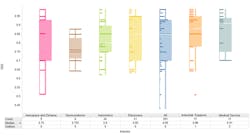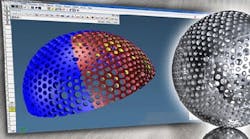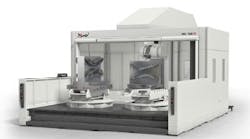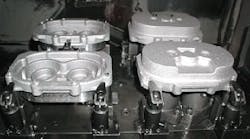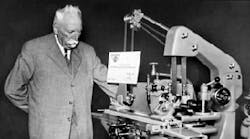Optimizing set-up times is a job that starts when the job i s quoted. Once a job is up and running, the way it is set up and the time it takes to re-establish that setup might as well be set in concrete.
While setting up a job is a process that is individualistic with each shop, there are standard features of job set up that are common to all, and that can be developed to maximize profit.
The common features start with considerations for the job as early as the quote process, and keeping careful records of the work that’s done to get it running.
Then, those records are kept and revised when a job comes back into the schedule. While it’s often the case that a job setup becomes well-established, it is when the job is repeated that time and costs can be squeezed out of the setup.
“The first thing we look at in a job is if it is a fit for our capabilities and what machine we will use to produce it. The machine we use is sometimes dictates the size of the stock and the material type of stock we will need to buy,” Harold K. (Bud) Hannah, president and chief executive officer of Pace Precision Products Inc., of DuBois, Pa., said.
The way that a part will be held often dictates the machine that is made on, Hannah said.
“Parts that need to be turned are usually a no brainer if it is straight turning and boring.
“However there are times when a hole is best served by circle interpolating on a vertical milling center. There is no cut and dried boiler plate way to standardize a way to quote holding methods. It is a gut feel that comes from experience,” Hannah said. Pace Precision Products (www.paceprecision.com) is a 41-year-old company that provides precision stamping, CNC machining and turning, and tool and die engineering work for the aerospace, defense, electronics, computer, nuclear, medical, automotive, energy, glass, petroleum, steel, locomotive and other industries.
For Robert E. Vitullo, president of Vitullo & Associates Inc. of Warren, Mich., the optimizing setup starts with the material and how it can be purchased as close to the size of the finished parts as possible. Vitullo & Associates (www.vitulloinc.com) is a 21-year-old company that engineers, designs and builds custom tooling and machinery for high-volume manufacturers in the automotive, durable goods and aerospace industries.
“You want to waste as little material as possible. Once the form of the material has been picked you work from first principles to establish machining datum that will allow the part to be controlled dimensionally from rough to finish machining,” Vitullo said.
Determining the material that will be used for a job includes consideration of bar, rod, sawed plate, waterjet cut blank, forging and castings, to ensure that it is as near the shape of the part as possible, he said.
Once the machine tool, the partholding and the material are determined, most shops generate a set-up process sheet to record the work. The set up sheet notes the basic information, and details all of the work and tools used for a job. Tools and toolholders that a job calls for, including types of turning tools, drill sizes, insert types and cutters are noted. Machining speeds and feeds, how the part is held, inspection data required and operators who do the setup and the machining all are recorded.
“We use a standard set-up sheet that has tool position, height offset, cutter comp., diameter, flute length, length from holder, an electronic data processing number for re-ordering and a space for notes,” Cecil Brackett, CNC programmer and machinist at Rosen Aviation in Eugene, Ore., said. Rosen Aviation (www.rosenaviation.com) provides a products, components and services to the aerospace and commercial aviation industries.
“Along with that we use a fixture, vise sheet to show X, Y, Z, values and any fixture offsets that need to be set. All of this plus a disk with the part program is stored in a folder in a filing cabinet. The cutting tools / fixtures are kitted and stored on shelves with a corresponding location number that is on the tool sheet. The programs and set-up sheets are also electronically stored,” Brackett said.
Scheduling and pre-staging the job helps to cut time out of the setup, and many shops put together a kit that includes the tools, fixtures and materials needed to do the work. The kit typically is placed at a machine before a previous job is done, so that setup for the new job can start as soon as the job that is running ends.
“We look at running similar types of work on the same machines with the same group of machinists,” James W. Rappa, manufacturing manager for Starlite Diversified Inc., said.
Starlite Diversified Inc. (www.starlitediv.com) has provided precision machining services for more than 25 years in Meadville, Pa. The shop offers precision and CNC machining, grinding, metal fabrication, mold building and repair and other precision machining related services.
“Once the job is in the schedule, the job packet is under review of the manufacturing manager. He explains the job or operation with the programmer if applicable, and or the lead man.
“While our machinists are on prior jobs, the lead man and the machinist review the work scope of their next job. Together they prepare a tool list, that includes tool lengths , diameters etc., and the list is sent to the tool crib to have the tools pulled from inventory, mounted into tool holders and placed as a kit that includes ,the raw stock ,the print, program, fixture, inspection equipment ,and the “Plan”. The kit is then sent to the work center, all before the machinist finishes his prior job,” Rappa said. He noted that Starlite Diversified puts work benches with an assortment of clamps, cubes, blocking, bolts, studs, washers and nuts at all of its machines to provide the machinist with ready supplies to get the work done.
Once the job is underway and run, most shops rely on, and require the machine operator to make notes on setup sheets to document what was done to get the job going. Often, documenting the setup will include sketches of the part in a fixture or taking photographs of the part, the fixtures, vises and clamps that hold it in place and the machine. Then, the sketches or photos become part of the setup sheet for future reference. While many shops continue to use paper for their setup sheets, some have moved to computers, and have developed electronic setup packages that include digital photos.
Toth Technologies (www.tothtech.com), in Pennsauken, N.J., treats the first run of a part as a development run, and designs the part flow as it is being run, Ted Toth Jr., president of the company, said. Many of the parts that Toth Technologies makes are unique items for the communications, telecommunications and aerospace industries, but when it does high volume work – about 5 percent of its total volume – the shop looks for ways to cut time out of its setups.
“Most of the time it (cutting setup time) is for cost reduction on second orders. How many parts can we run in one set-up, how many set-ups can we run in one operation, how many parts can we machine before replacing tools,” Toth said.
While the first run on a part is being made, Toth Technologies’ shop manager gives the machine operator a basic part traveler that lists service and quality requirements. The operator updates the traveler with detailed operation descriptions and the manager reviews and updates it in the shop’s computer system when the job is done, Toth said. The manager also is responsible for reviewing operation set-up sheets to make sure all information is legible and clear.
If a prototype part grows into production jobs, the shop’s production manager reviews it to see if some operations can be merged.
“They use the details (from the prototype sheets) but we never delete the prototype sheets, we may need to make spares,” Toth said. As a part moves into production a second sheet, a process sheet, is added to document in-process inspection and statistical process control on part features, he added.
In its tradition of keeping up with technology, Toth said his shop is testing a new, paperless system that was designed in-house for process improvement. The computerized system stores data from operation set-up sheets and photos of the set ups online, and provides access to that data on computers that most of the shop’s machinists have.
However, Toth noted that his shop’s computer server is not big and powerful enough to store thousands of photos, and display them quickly.
Rosen Aviation has, similarly, gone to the use of computer data storage for jobs, but still hangs onto its paperwork, Brackett said. The shops’ setup sheets and part travelers are stored with computer disks that contain part programs, so that any new machinist who runs the job would be familiar with it and quickly up to speed with little training. Also, Rosen Aviation stores cutting tools and fixtures for parts as kits on shelves, and records corresponding location number that is on tool sheets for easy reference in the future, Brackett said.
“One of our company policies is continuant improvement which includes all aspects of a job that a machinist may be running,” he noted.
Hannah also said his shop details and stores process sheets so that a new person would be able to understand the process and run the job in the future.
“We are always open to new ways to process the part for better quality, better production method or cost saving measures,” Hannah said, but added that his shop always keeps in mind that the integrity and quality of the part cannot be sacrificed.
“After a production run is completed we immediately check for accountability in our process,” Hannah said.
“We record any changes we may want to make on the next run and determine if we can generate a cost saving for our customer. Reducing setup time is a difficult issue. It can be naturally be reduced by keeping all the fixtures and special tooling together for each job and readily available for the next time you produce the job,” he said. But, he noted that, while that saves time and money in future setups, it can be difficult to manage.
“We usually know whether (when a job) will be a repeat job, and therefore all the hard tooling is stored under the job number and the soft tooling – process records and programs —are stored both as hard copies in a file and electronically stored usually in three places,” Hannah said. Pace Precision Products stores its soft tooling on a desktop personal computer that is dedicated for programming and storage, on a laptop computer that is used by the shop’s leadman, and on the computer on the machine if it has space available. That back-up allows all of the programs to be easily transferred electronically between machines and computer systems, he said, while ensuring their integrity and permanence.
